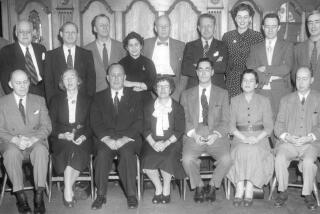In 1943, a scientist took a bike ride on LSD. Brian Blomerth illustrates his historic trip
- Share via
No cars were available for Albert Hofmann to drive home from Sandoz Pharmaceuticals in Basel, Switzerland, on April 19, 1943. World War II’s rationing limited gasoline use in automobiles to medical emergencies, and although the chemist was enduring what he would eventually characterize in his journal as a “severe crisis” late that day, it is perhaps a miracle that the law prevented him from climbing behind the wheel of a motorized vehicle. Hofmann’s research involved synthesizing plants’ compounds for medicinal use, and on that Monday, in the laboratory of a huge Swiss pharmaceutical company, he would become the first person in history to purposely ingest 250 micrograms of lysergic acid diethylamide — LSD.
Afterward, when the scientist was presumably as high as a kite soaring above the Jura Mountains, Hofmann biked home.
New York City-based cartoonist Brian Blomerth details an event in his graphic novel debut that’s seemingly tailor-made for him. Working in the grandiose, psychedelic style that he has for years, Blomerth’s “Bicycle Day” imports Hofmann’s riveting yarn from the annals of medical history to comics with busy panels and rampant anthropomorphism.
Hofmann takes on a dog’s form in “Bicycle Day.” In fact, in Blomerth’s serial VICE strip and more, everyone is a sentient canine. He unleashed the hounds for 2017’s “iPhone ’64: A User’s Guide,” which, in energetic Rapidograph pen drawings and patterned backgrounds, mocked consumerism and the religion we’ve constructed around personal technology. The sax-playing dogs in “iPhone ’64” slot this zine in the “funny animals” comics genre, wherein wildlife is perched up on their hind legs, walking around, being expressive, and, in the case of “Bicycle Day,” consuming hallucinogenic drugs.
When Hofmann first synthesized LSD in 1938, he was hoping to secure a circulatory and respiratory stimulant as a result of his work with a parasitic fungus called ergot. The derivative didn’t pass muster during colleagues’ tests.
“It was unremarkable,” writes pharmacologist Dennis McKenna in a foreword to Blomerth’s book. “With a sigh, Hofmann put it on the shelf, went to work on other compounds, and forgot about it.”
Five years later, the chemist found himself pondering the LSD he’d tucked away. Despite the test results, did his compound have value? On April 16, 1943, he whipped up a fresh batch and was accidentally exposed to a small dose. He described an hours-long “stream of fantastic pictures, extraordinary shapes with intense, kaleidoscopic play of colors” in a report for chemist Arthur Stoll, whose tongue on Blomerth’s pages rests in a long white dog-beard. To confirm his belief that the compound had caused a “remarkable experience,” he purposely drank the mother lode — a sizable 250 micrograms — a few days later.
Full-page panels follow a lanky, floppy-eared Hofmann, clad in a rumpled yellow suit, around his lab, and then stoned, pedaling home with his assistant through Blomerth’s intricate and shimmering Basel. Rainbow stripes line the path behind him — a nod to the history of acid users’ accounts of prismatic “trails” following moving objects — and bulbous typography mingles with abstractions and perverse distortions of the once-gentle creatures that had pranced along his earlier commutes.
Even wartime horrors are streaked in psychedelic hues in “Bicycle Day”: Blood runs red when Stoll references Nazis (the Warsaw ghetto would be wholly destroyed by German troops that May), but a two-page battlefield spread gets bright yellow gunsmoke and purple haze. Blomerth goes for levity more than anything else, however. Holocaust references are sparse outside of McKenna’s smart essay, and although he and the artist highlight LSD’s importance to medicine — McKenna cites its role as a catalyst for “a revolution in neuroscience”; Blomerth underscores its role in treating depression in cancer patients — there’s no proselytizing in the comic. Named for the international holiday that marks Hofmann’s experiment, “Bicycle Day” is instead largely Disney-on-designer-drugs.
Even ahead of the acid trip, grizzly bears in fashionable scarves recline under partially melted pastel-hued trees. Floating geometric shapes and day-glow confections, adjacent to elastic hand-lettered text that nearly crashes into word balloon outlines, conjure the “comix” of late-‘60s era underground newspapers. In its integration of reproduced graph paper and paint-splattered textures, Blomerth’s comic is a cousin to Push Pin Studios’ visionary illustrative work as well as Aussie Martin Sharp’s psychedelic concert handbills, particularly in the rubbery attributes of the book’s topography.
Blanketed in lush gradients, clouds puddle atop the ever-present Jura mountain range — iced over and blotted with shadows, it looks like doughy wet pastry compared to Blomerth’s architecture, which is organized and exacting. Building exteriors are drawn in obsessively ruled lines, and facades are dressed in ornate flourishes. Brilliant color systems used for village houses perched in the mountains have them dazzling in the backdrop, and the home that Hofmann shares with his family is flecked with clusters of stacked rainbow slats that pop from the brown and beige doors and floorboards. Home is abundantly welcoming for Hofmann, and Blomerth depicts a rich devotion between his chemist and wife, Anita. But when Hofmann dosed himself seven decades ago, there was no comfort to be found at his abode. Rather, Blomerth’s gargantuan, wart-ridden witch and once-familiar furniture that suddenly “assumed grotesque, threatening forms,” per Hofmann’s recollection, populate the foyer. Yeesh.
“Am I dead?” asks Blomerth’s Hofmann — a prescient question given the similar queries that a hallucinating George Harrison had for Peter Fonda during the Beatles’ inaugural LSD experiences 20 years later. It was a bad trip in Basel, but Hofmann didn’t actually die until he was 102, well after initiating a crucial field of research for generations of scientists to continue in his iridescent wake.
“LSD is an example of all that is good about humanity: a triumph of science, curiosity, imagination, spirit, and the unending search for meaning and truth,” writes Dennis McKenna in Blomerth’s book. “Hofmann’s skilled hands created a miraculous molecule that was (and still is) one of the most significant tools ever discovered for the understanding of the mind and consciousness.”
::
Brian Blomerth
Anthology Editions; 192 pp., $30.00
Umile’s writing has appeared at Hyperallergic, the Chicago Reader, the Washington City Paper, and elsewhere. He lives in Brooklyn, N.Y.
More to Read
Sign up for our Book Club newsletter
Get the latest news, events and more from the Los Angeles Times Book Club, and help us get L.A. reading and talking.
You may occasionally receive promotional content from the Los Angeles Times.








